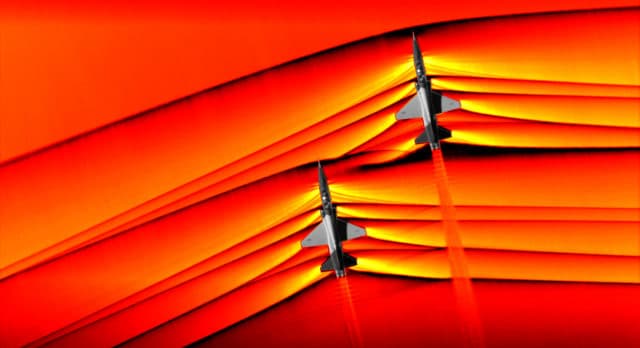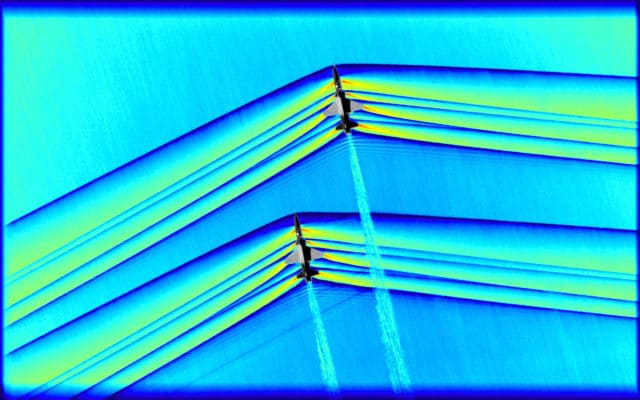Supersonic Shockwave Interactions
These photographs are from last March but they’ve just been featured in Nature magazine’s collection of the best science images of the year

NASA has been exploring the potential of photographic technology resulting in these beautiful air-to-air photographs of supersonic aircraft and how their shockwaves interact.
Two T-38 Talon twinjet supersonic jet trainers were flown out of Edwards Airforce Base while a NASA B-200 King Air installed with the imaging system flew in a pattern at 30,000 feet. The jet trainers were then to fly underneath the B-200 in formation, reaching supersonic speeds exactly as they passed beneath it. The cameras could record for just three seconds, so they had to start exactly as the T-38s came into the frame. These images are the result of everyone doing everything exactly right.
“We’re looking at a supersonic flow, which is why we’re getting these shockwaves,” said Neal Smith, a research engineer with AerospaceComputing Inc. at NASA Ames’ fluid mechanics laboratory.
“What’s interesting is, if you look at the rear T-38, you see these shocks kind of interact in a curve,” he said. “This is because the trailing T-38 is flying in the wake of the leading aircraft, so the shocks are going to be shaped differently. This data is really going to help us advance our understanding of how these shocks interact.”

The T-38 aircraft flew at supersonic speeds just 30 feet apart in order to produce shockwaves which are associated with what we on the ground hear as a sonic boom. The goal is to better understand how these shockwaves interact with aircraft plumes and each other in order to confirm the design of the X-59 Quiet SuperSonic Technology X-plane (X-59 QueSST), a supersonic plane which will produce shockwaves which avoid the sonic boom. The researchers hope that this will result in supersonic flights over land without disruption on the gorund.

NASA Captures First Air-to-Air Images of Supersonic Shockwave Interaction in Flight
In order to capture these images, the King Air, flying a pattern around 30,000 feet, had to arrive in a precise position as the pair of T-38s passed at supersonic speeds approximately 2,000 feet below. Meanwhile, the cameras, able to record for a total of three seconds, had to begin recording at the exact moment the supersonic T-38s came into frame.
“The biggest challenge was trying to get the timing correct to make sure we could get these images,” said Heather Maliska, AirBOS sub-project manager. “I’m absolutely happy with how the team was able to pull this off. Our operations team has done this type of maneuver before. They know how to get the maneuver lined up, and our NASA pilots and the Air Force pilots did a great job being where they needed to be.”
“They were rock stars.”
I always get a bit excited at a sonic boom: the first one I ever heard was coincidentally at Edwards Air Force Base when I got taken on a school bus to watch the space shuttle landing. But I can understand not wanting to live under the flight path of a supersonic jet and I’d welcome the opportunity for a new passenger jet to pick up where the Concorde left off.








Estraordinary pictures. During our training for the ATPL we were shown photos of shock waves, but nothing at the technical level of the images that we see here.
The old technique, if I remember correctly, was called “Schlieren photography”.
A new supersonic jet airliner? I doubt it, Sylvia. All those hard edges that are visible in the photos not only represent shock waves, but also associated drag. We were told by our instructors that this meant “lots of drag”, especially in the transsonic area where the aircraft accelerates and becomes truly supersonic. Which will require a lot of fuel. With the looming climate change (and possible catastrophy), this will not be a popular development any more. Airships with sun panels to add to propulsion from engines may become once more feasible; for that, either a way has to be found to make hydrogen safe, or otherwise an alternative for helium. Because that is in extremely limited supply and is not renewable.
This is considered a variant of schlieren photography – they call it background-oriented schlieren. Basically instead of using collimated light, they use a textured backgrund (in this case, the ground) and a lot of software processing.
> These images are the result of everyone doing everything exactly right
As opposed to the usual stories here of where someone does everything exactly wrong…
> All those hard edges
One of the routes for research is what kind of “soft” edges can have a major effect.
For example, the F-102 that could barely go supersonic, and the not-much-different F-106 that had no trouble because it had the “coke bottle” area-rule fuselage.
The Whitcomb transonic area rule says if you have a sudden increase in cross-section (for example, where the wings attach) then you have an increase in transonic/supersonic “wave” drag. If you compensate by necking the fuselage down, then the drag goes down.
People are hoping by exploiting effects like this, that we can have a) no sonic booms and/or b) a lot less supersonic drag
Gene,
You are absolutely correct. Area rule has also been successfully applied to subsonic aircraft, one of the first ones was the Falcon 50, a business trijet, forerunner of the 7X.
The complexity of, what you call “necking down” has so far prevented or at least limited area rule to be used in the construction of airliners. It is an added complexity. It would affect the uniformity of the cabin cross serction and add substantially to the cost per unit. Maybe now that fuel consumption is going to play an increasing role in the operating cost, this may have to change.
The last word has not yet been spoken, but I doubt very much that the SST will make a come-back. Not in my lifetime.
But then, we will never know. If manufacturers can revive an old proposal to bring passenger transports in a low orbit, and do so economically: maybe one day we can fly from London to Bejing, do business and return the same day.
Heard somewhere that the ‘area rule’ applied also to the 747-400.
When they extended the ‘upstairs bubble’ it made the cross-section more consistent until the wings showed up. Jon
I was working a day shuttle landing mission , don’t remember which one. I remember looking up at the shuttle and seeing the shockwave as if it was a wake from a boat. Trailing all the way from the nose of the shuttle trailing back to the ground. I took my $10 sun glasses off and it disappeared. Put them back on and there it was. The sun glasses were supposed to be blue blockers. Only time this ever happened and I had lost the sun glasses shortly after that event.